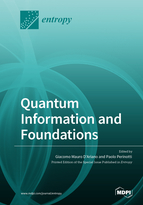Quantum Information and Foundations
A special issue of Entropy (ISSN 1099-4300). This special issue belongs to the section "Quantum Information".
Deadline for manuscript submissions: closed (28 February 2018) | Viewed by 122090
Special Issue Editors
Interests: quantum information; foundations of quantum physics; foundations of quantum field theory; tension between quantum theory and general relativity
Special Issues, Collections and Topics in MDPI journals
Interests: quantum foundations; quantum information theory; quantum cellular automata and quantum walks; foundations of quantum field theory; tension between quantum theory and general relativity
Special Issue Information
Dear Colleagues,
Quantum information has dramatically changed information science and technology, looking at the quantum nature of the information carrier as a resource for building new information protocols, designing radically new communication and computation algorithms, and ultra-sensitive measurements in metrology, with a wealth of applications. On the fundamental side, the new discipline has led us to regard quantum theory itself as a special theory of information, and has opened routes for exploring solutions to the tension with general relativity, based for example on the holographic principle, on non-causal variations of the theory, or else on the powerful algorithm of the quantum cellular automaton which has revealed new routes for exploring quantum fields theory both as a new microscopic mechanism on the fundamental side, and as a tool for efficient physical quantum simulations on the practical side. In this golden age of foundations, an astonishing number of new ideas, frameworks and results, spawned by the quantum information theory experience, have revolutionized the way we think about the subject, with a new research community emerging worldwide, including scientists from computer science and mathematics.
Prof. Giacomo Mauro D'Ariano
Dr. Paolo Perinotti
Guest Editors
Manuscript Submission Information
Manuscripts should be submitted online at www.mdpi.com by registering and logging in to this website. Once you are registered, click here to go to the submission form. Manuscripts can be submitted until the deadline. All submissions that pass pre-check are peer-reviewed. Accepted papers will be published continuously in the journal (as soon as accepted) and will be listed together on the special issue website. Research articles, review articles as well as short communications are invited. For planned papers, a title and short abstract (about 100 words) can be sent to the Editorial Office for announcement on this website.
Submitted manuscripts should not have been published previously, nor be under consideration for publication elsewhere (except conference proceedings papers). All manuscripts are thoroughly refereed through a single-blind peer-review process. A guide for authors and other relevant information for submission of manuscripts is available on the Instructions for Authors page. Entropy is an international peer-reviewed open access monthly journal published by MDPI.
Please visit the Instructions for Authors page before submitting a manuscript. The Article Processing Charge (APC) for publication in this open access journal is 2600 CHF (Swiss Francs). Submitted papers should be well formatted and use good English. Authors may use MDPI's English editing service prior to publication or during author revisions.
Keywords
- Quantum information
- quantum foundations
- probabilistic theories
- quantum computation
- quantum communications
- quantum field theory
- quantum cellular automata
- quantum walks
- quantum simulations








